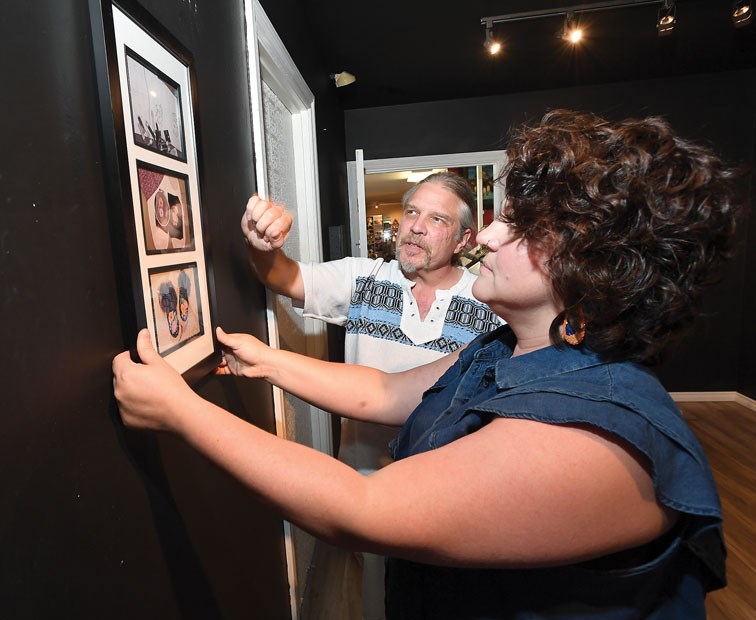Paint sparks flew when Michael Kast first met Lynette La Fontaine.
The two were the first pairing ever selected by the Community Arts Council (CAC) to be their Artists-In-Residence at the Studio 2880 arts complex. That had only ever been a singular position in the past.
The CAC felt they could host two artists at the same time and so gave these two a try, despite them having never known each other before, much less worked on art together. The CAC gave them no mandate to collaborate, but offered the suggestion. It was too late. They were already alive with collaboration.
"The ideas were flying across the table right from the first lunch," said Kast. "One would think that a beading specialist and a digital photographer specialist wouldn't have much in common - and it was true, we didn't, as far as our mediums - but the way creative ideas are formed and how we approach creativity, that was something we both kinda grooved on."
La Fontaine creates amazing bead-work in the tradition of her Metis heritage. Moccasins are her signature creations, but only one facet of her work.
Kast's main tool of the art trade is the camera in conjunction with the computer - digital data art.
Yet they both are also painters. They had that nexus in common.
And so, with the click of the shutter and the pluck of the needle, with the swipe of the brush and the scrape of the blade, two solitary artists became an unlikely team. Their collaboration show opens tonight at the Studio 2880 Feature Gallery.
"We were able to really put together these ancient artisan forms and these cutting edge forms of art," said La Fontaine.
They were in mental lockstep that they were involved, through this teamwork, in advancing culture itself. They were contributing some articulate words to the conversation on national identity.
"What I'm pursuing is how do I express my Indigeneity in the colonial context? How do I build and reflect my Indigenous self since the cultural disruption?" La Fontaine wondered out loud, and Kast agreed that if non-Aboriginal and Indigenous alike worked towards that goal together, the entire nation would gain. Aboriginal cultures in their Canadian spectrum have been systemically and deliberately bullied down by institutional forces, in the recent history of Canada, so now it is only right, he said, to extend the non-Aboriginal hand to help those cultures get back on their feet. It costs nothing to do so, it doesn't diminish the overall Canadian culture to uplift our Aboriginal members, and it is through artistic endeavours like this one that healing can be shown with meaning and substance.
That reconciliation will require trust on all sides, and it will require work by all parties. In that way, Kast and La Fontaine are again an example to follow. These dozen-or-so pieces of new, original art were created together but usually in turns.
"He's a morning person; I'm a night person," La Fontaine said, explaining how their use of the studio worked to mutual advantage. Not all artist-in-residence work was in aid of this collaboration show. "Social media was helpful, too. When we were working on something together we could use Instagram or just text each other."
"I'm OK with that (turn-taking style of shared creation)," said Kast. "I'm a pretty solitary person. I'm an introvert. But that's not to say I was ever uncomfortable with Lynette, just that I'm naturally most comfortable working alone."
"And even though I am an extrovert," La Fontaine carried on, "I do find a certain freedom in working alone."
They gave each other encouraged permission to contribute to certain art pieces in the studio whenever the inspiration struck. That's how most of the work in this exhibition came into being. It was made together, in fits and starts and often without the other in the room or in the know.
"That was a real personal growth experience for me," Kast said. "I needed to let go. I had to learn to do whatever I wanted to do, leave, and when I came back be ready to have that work I'd done be completely changed. And I had to learn to use those changes as my own invitation to add more myself. You had to be able to step aside, and you had to be able to step in. It was amazing. We fed off each other's exuberance."
Knowing when a piece was truly finished could be a somewhat tricky conclusion to reach.
"It's hard, letting go. Sometimes you just have to decided that's it, it's done, or you could keep nudging at it forever," Kast said.
"When the canvas stops calling me back, that's when I know it's done," La Fontaine said.
Their finished efforts are on the walls of Studio 2880 now, unveiled today with a reception from 5-7 p.m. The exhibition is entitled Art Of The Matter: Finding Our Way and will be on display until Aug. 4.



